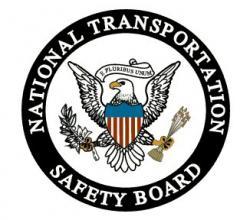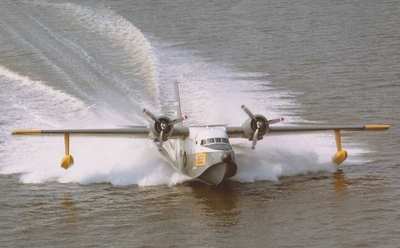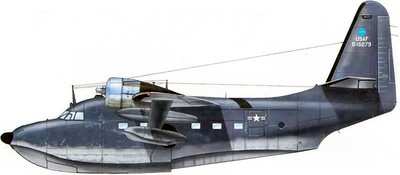Only Minor Injuries In Crash... But The Albatross Is A
Mess
 An NTSB Preliminary report indicates that the cause behind the
downing of a Grumman G-111 Albatross appears to be related to
engine failure. The aircraft went down with only a few hours
on the engines since a Major Overhaul that had occurred over a year
earlier, and was operating under a Special Flight Permit.
An NTSB Preliminary report indicates that the cause behind the
downing of a Grumman G-111 Albatross appears to be related to
engine failure. The aircraft went down with only a few hours
on the engines since a Major Overhaul that had occurred over a year
earlier, and was operating under a Special Flight Permit.
NTSB Identification: ERA10LA050
14 CFR Part 91: General Aviation
Accident occurred Thursday, November 05, 2009 in Ft Pierce,
FL
Aircraft: GRUMMAN AIRCRAFT ENG CORP G-111, registration:
N120FB
Injuries: 1 Minor, 2 Uninjured.
This is preliminary information, subject to change, and may
contain errors. Any errors in this report will be corrected when
the final report has been completed.
On November 5, 2009, about 1534 eastern standard time, a Grumman
G-111, N120FB, was substantially damaged during a forced landing
while performing an air return to the St. Lucie County
International Airport (FPR), Ft. Pierce, FL. Day visual
meteorological conditions prevailed, and no flight plan had been
filed. The intended destination for the flight was Okeechobee
County Airport (OBE), Okeechobee, FL. The two pilots and one
additional crew member received minor injures. The flight was
conducted under 14 Code of Federal Regulations Part 91.
An eyewitness reported seeing the airplane depart from runway 32
and become airborne near the intersection of taxiway "C7." While
the witness observed the landing gear begin to retract the left
engine began emitting several "loud pops" then white colored smoke
began to discharge from the exhaust. The witness reported hearing
an increase in engine noise and observed the airplane begin a left
turn. The airplane then impacted terrain, went through an airport
boundary fence, and came to rest near an airport service road. Upon
arrival at the accident location the witness observed fuel coming
out of the right wing and assisted the occupants in exiting the
airplane.

File Photo
In an interview with the Safety Board the captain reported that
while on the runway preparing for takeoff they advanced the power
levers to achieve 30 inches of manifold pressure, checked all the
engine gauges, then advanced the power levers to 40 inches of
manifold pressure, released the brakes, and preformed a normal
takeoff. During the initial climb the captain commanded the gear to
be retracted, shortly after the gear handle was placed in the "UP"
position, he heard a loud "bang followed by three to four smaller
bangs." The captain commanded the checklist to be run for an engine
failure in flight. The first officer confirmed that the left engine
was the affected engine and immediately began feathering the
propeller. Once the propeller had been feathered the captain
confirmed that by looking outside and noticing the propeller in the
feather position. The captain further reported that the right
engine was producing the maximum power available and was indicating
55 inches of manifold pressure however the airplane was not able to
maintain altitude.
Unable to achieve an airspeed greater than 95 ¬to 96 knots
indicated the crew confirmed that the gear and flaps were in the
retracted or "UP" position; however the captain could not center
the slip/skid indicator completely. During this time the captain
attempted to return to the airport for an emergency landing however
he was unable to maintain altitude and attempted to land on an
airport perimeter road, impacting the airport fence in the process.
After the airplane came to a stop the captain shut down the
engines, fuel pumps, and other items as required to secure the
airplane. As he exited the aircraft he saw fuel coming out of the
right wing onto the ground. The airplane had been fueled on October
29, 2009 with 284 gallons of 100LL aviation fuel. The captain
further reported that both engines had less than 20 hours since
overhaul and that their takeoff weight was approximately 27,000
pounds.

The Federal Aviation Administration (FAA) inspector that
responded to the accident scene reported the left engine propeller
was in the feathered position, the right engine exhibited little
damage, approximately 150 gallons of fuel was removed from the left
fuel tanks and fuel samples were taken from both engines. The fuel
samples indicated 100LL fuel and contained no water or contaminants
present. The right wing tank had been breeched during the accident
sequence and there was no fuel present, however an estimated 150
gallons of fuel had spilled on the ground under the right wing.
They were unable to verify control continuity due to the damage to
the under side of the airplane. The inspector calculated that the
maximum allowable takeoff weight was 30,605 pounds.
The captain age 58, held an airline transport pilot certificate,
with ratings for multi-engine land and sea, including a type rating
for the accident airplane. His most recent FAA first-class medical
was issued January 22, 2009. At that time, the pilot reported a
total flight time of 9,800 hours of flight experience.
The First Officer age 70, held an airline transport pilot
certificate, with ratings for airplane multi-engine land and sea
including a type rating for the accident airplane, a commercial
pilot certificate with a rating for airplane single engine land and
rotorcraft-gyroplane, and a private pilot certificate with a rating
for glider. His most recent FAA first-class medical was issued
October 6, 2009. At that time, the pilot reported a total flight
time of 11,500 hours of flight experience.
The airplane was issued an airworthiness certificate by the FAA
on July 21, 1983 and was registered to the owner on October 1,
2007. It was equipped with two Curtiss-Wright engines that had
undergone major overhauls on February 29, 2008. An entry dated
October 12, 2009 indicated that the airframe had a total time in
service of 3,747.1 hours and the engines had 3.1 hours since major
overhaul. On November 5, 2009 the airplane was issued a special
flight permit to conduct the flight to OBE.
The 1553 reported weather observation at FPR winds from 360
degrees at 9 knots with gusts of 14 knots; visibility 10 miles,
broken cloud layer at 4,000 feet above ground level, temperature 25
degrees C, dew point 16 degrees C, altimeter of 30.11 inches of
mercury.
 ANN's Daily Aero-Term (11.28.25): Unmanned Aircraft System (UAS)
ANN's Daily Aero-Term (11.28.25): Unmanned Aircraft System (UAS) ANN's Daily Aero-Linx (11.28.25)
ANN's Daily Aero-Linx (11.28.25) Airborne 11.21.25: NTSB on UPS Accident, Shutdown Protections, Enstrom Update
Airborne 11.21.25: NTSB on UPS Accident, Shutdown Protections, Enstrom Update Airborne 11.26.25: Bonanza-Baron Fini, Archer v LA NIMBYs, Gogo Loses$$$
Airborne 11.26.25: Bonanza-Baron Fini, Archer v LA NIMBYs, Gogo Loses$$$ Airborne-NextGen 11.25.25: EHang Manned Flt, Army UAVs, Starship V3 Booster Boom
Airborne-NextGen 11.25.25: EHang Manned Flt, Army UAVs, Starship V3 Booster Boom





